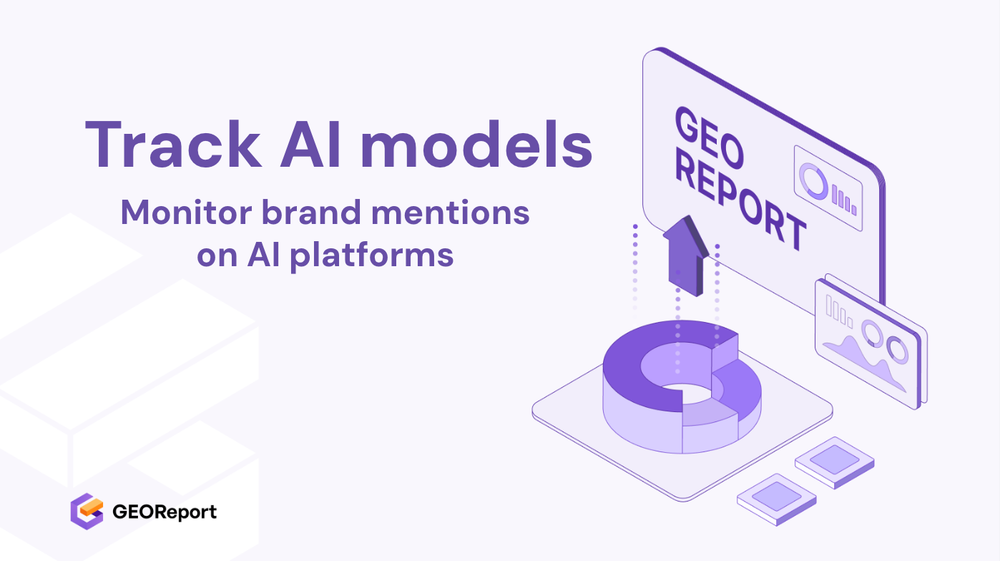BLUF: Brands should track mentions across ChatGPT, Gemini, Claude, and Perplexity to manage reputation, identify emerging trends, optimize for AI visibility, and gain a competitive edge in the evolving landscape of Generative Engine Optimization (GEO).
The Dawn of Generative Engine Optimization (GEO)
The way people seek and consume information is undergoing a monumental shift. Traditional search engines like Google are now just one avenue. Large Language Models (LLMs) such as ChatGPT, Gemini, Claude, and Perplexity are rapidly becoming preferred starting points for information discovery. This shift necessitates a new approach to digital visibility – one centered around Generative Engine Optimization (GEO).
- GEO Defined: Generative Engine Optimization (GEO) is the process of optimizing brand presence and information to be accurately and favorably represented in the outputs of Large Language Models (LLMs) and other generative AI systems. It goes beyond traditional SEO by focusing on how AI synthesizes and presents information, rather than just ranking on a list of search results.
The Criticality of Tracking Mentions in the Age of AI
Why is tracking brand mentions across these platforms so vital? The answer lies in understanding the implications of these AI systems on brand reputation, market understanding, and overall business strategy.
- Reputation Management Redefined: In the past, brands meticulously monitored social media and online reviews to manage their reputation. Today, LLMs can shape public perception in profound ways. A negative or inaccurate mention in a ChatGPT response, for example, can reach a vast audience instantly, impacting brand trust and purchase decisions.
- Example: Imagine a travel company consistently misrepresented as having poor customer service in ChatGPT's summaries of travel options. Without monitoring, they'd be unaware of this negative portrayal and unable to correct the misinformation.
- Competitive Intelligence Evolved: Tracking mentions allows brands to understand how they are positioned relative to competitors. Are your competitors being recommended more frequently? Are specific aspects of your products or services being highlighted by AI? This information is invaluable for refining marketing strategies and product development.
- Trend Identification Amplified: LLMs are trained on massive datasets and can identify emerging trends faster than traditional market research methods. By monitoring the topics and themes associated with your brand in these AI systems, you can gain early insights into evolving customer needs and preferences.
- Proactive Content Optimization: When you understand how LLMs are referencing your brand, you can optimize your content to align with their information needs. This can involve creating more comprehensive product descriptions, publishing detailed FAQs, or structuring your website data for better AI comprehension.
- AI Visibility as a Key Performance Indicator (KPI): AI visibility, the measure of how prominently and favorably your brand is represented in AI-generated content, is becoming a critical KPI. Tracking mentions across LLMs provides a direct measure of your AI visibility and allows you to track progress over time.
The LLM Landscape: A Brief Overview
Before diving into the practical aspects of tracking mentions, let's briefly examine the key players in the LLM landscape.
- ChatGPT (OpenAI): Known for its conversational abilities and versatility, ChatGPT is widely used for generating text, answering questions, and providing summaries. It's a general-purpose model accessible to a broad audience.
- Reference: OpenAI's official ChatGPT documentation
- Gemini (Google): Gemini, successor to LaMDA, is deeply integrated into the Google ecosystem. It excels at understanding and generating different creative text formats, like poems, code, scripts, musical pieces, email, letters, etc., and answers your questions in an informative way. It’s optimized for Google’s search infrastructure.
- Reference: Google AI Blog on Gemini
- Claude (Anthropic): Focused on safety and ethical AI development, Claude is designed to be helpful, harmless, and honest. It's particularly strong in summarizing documents and providing detailed explanations.
- Reference: Anthropic's website
- Perplexity AI: Perplexity AI is a search engine powered by LLMs that provides answers with citations. It excels at research and information retrieval, making it a valuable tool for knowledge workers. It directly challenges traditional search by offering concise answers, not just a list of links.
- Reference: Perplexity AI's "About" page
Each platform has its own strengths, user base, and approach to generating information. Understanding these nuances is crucial for tailoring your monitoring efforts.
The Challenges of Tracking Mentions Across LLMs
While the importance of tracking mentions is clear, the process is not without its challenges.
- Scalability: LLMs generate vast amounts of text daily. Manually tracking mentions would be impossible. Automated solutions are essential.
- Accuracy: LLMs can sometimes hallucinate or misrepresent information. Identifying and correcting these inaccuracies requires careful analysis.
- Contextual Understanding: It's not enough to simply identify mentions of your brand. You need to understand the context in which they are mentioned. Is the sentiment positive, negative, or neutral? What specific aspects of your brand are being discussed?
- Attribution and Source Identification: Determining the original source of information used by LLMs can be difficult. This is particularly challenging when LLMs synthesize information from multiple sources.
- API Access and Limitations: Accessing LLM outputs programmatically often requires API access, which may be subject to limitations and costs.
Addressing the Challenges: Tools and Techniques
Despite these challenges, several tools and techniques can help brands effectively track mentions across LLMs.
- AI-Powered Monitoring Tools: Specialized tools that use AI to monitor LLM outputs for brand mentions, sentiment analysis, and context understanding are emerging. These tools often provide dashboards and reporting capabilities to track progress over time.
- API Integration: Integrating directly with LLM APIs allows you to programmatically query the models and analyze their outputs. This approach offers greater control and customization.
- Prompt Engineering: Carefully crafted prompts can be used to elicit specific information from LLMs about your brand and competitors.
- Human Review and Validation: While automation is essential, human review is still necessary to validate the accuracy of AI-generated outputs and identify subtle nuances that automated systems may miss.
- Hybrid Approach: Combining automated monitoring with human review provides the most comprehensive and reliable solution.
A Practical Framework for Tracking Mentions
Here’s a step-by-step framework for implementing a mention-tracking strategy:
- Define Your Objectives: What specific information are you trying to gather? Are you focused on reputation management, competitive intelligence, or trend identification?
- Identify Relevant Keywords: Create a list of keywords related to your brand, products, services, and competitors.
- Select Your Monitoring Tools: Choose the AI-powered monitoring tools or API integrations that best meet your needs. Consider factors such as scalability, accuracy, and cost.
- Configure Your Monitoring System: Set up your monitoring system to track mentions of your keywords across the selected LLMs.
- Analyze the Data: Regularly analyze the data to identify trends, patterns, and potential issues.
- Take Action: Use the insights gained to optimize your content, refine your marketing strategies, and address any negative mentions.
- Monitor and Refine: Continuously monitor your monitoring system and refine your keywords, prompts, and analysis techniques as needed.
Example Workflow: Using Prompt Engineering for Brand Monitoring
Let's illustrate how prompt engineering can be used to monitor brand mentions in ChatGPT:
- Define the Objective: The objective is to understand how ChatGPT describes your brand's key product compared to a competitor's.
- Craft the Prompt:
- "Compare and contrast [Your Brand’s Product Name] with [Competitor’s Product Name]. Focus on features, user reviews, and overall value proposition."
- Analyze the Output: Carefully review the response from ChatGPT. Pay attention to:
- Key differences highlighted by the model.
- Sentiment expressed towards each product.
- Sources cited (if any).
- Iterate and Refine: Adjust the prompt to focus on specific aspects of the product or to elicit more detailed information. For example:
- "What are the top 3 user complaints about [Your Brand’s Product Name]?"
- "How does [Your Brand’s Product Name] compare to [Competitor’s Product Name] in terms of ease of use?"
This iterative process allows you to gain a deeper understanding of how LLMs perceive your brand and its products.
The Impact of Tracking Mentions on GEO
Tracking mentions across LLMs is not just about reputation management or competitive intelligence. It's a core component of Generative Engine Optimization (GEO).
- Optimizing for AI Comprehension: By understanding how LLMs are referencing your brand, you can optimize your content to make it easier for AI to understand and accurately represent your brand. This includes using clear and concise language, structuring your data for better AI comprehension, and providing comprehensive information.
- Building E-E-A-T (Experience, Expertise, Authoritativeness, and Trustworthiness) Signals: LLMs rely on E-E-A-T signals to determine the credibility and reliability of information. By actively managing your brand mentions and ensuring that your content is accurate, authoritative, and trustworthy, you can strengthen your E-E-A-T signals and improve your AI visibility.
- Example: If ChatGPT consistently misattributes a key innovation to a competitor, you can correct this misinformation by providing more prominent and verifiable evidence of your innovation on your website and in your marketing materials. This will help to strengthen your authority on the topic and improve your chances of being accurately represented by LLMs in the future.
- Influencing AI-Generated Content: By proactively managing your brand mentions, you can influence the way LLMs generate content about your brand. This includes ensuring that your brand is accurately represented, that your key messages are highlighted, and that any negative or inaccurate information is corrected.
The Future of GEO and AI Visibility
The field of Generative Engine Optimization is still in its early stages, but it's clear that it will play an increasingly important role in the future of digital marketing. As LLMs become more sophisticated and more widely used, brands that prioritize AI visibility will gain a significant competitive advantage.
- Semantic SEO Evolving into AI-First SEO: Semantic SEO focused on understanding search intent. AI-First SEO builds upon this by optimizing content for AI comprehension and generation.
- The Rise of AI-Generated Content Monitoring Platforms: We can expect to see the emergence of specialized platforms that provide comprehensive monitoring and analysis of AI-generated content. These platforms will offer features such as sentiment analysis, source identification, and AI-driven content optimization recommendations.
- The Importance of Structured Data: Structured data (schema markup) will become even more important for helping LLMs understand the meaning and context of your content.
What Everyone Else Misses: The Proactive vs. Reactive Approach
Most brands are taking a reactive approach to GEO, waiting to see how LLMs represent their brand before taking action. The most successful brands will be those that take a proactive approach, actively managing their brand mentions and optimizing their content for AI comprehension from the outset.
Conclusion:
Tracking mentions across ChatGPT, Gemini, Claude, and Perplexity is no longer a luxury; it's a necessity. By understanding how these AI systems perceive and represent your brand, you can protect your reputation, gain a competitive edge, and optimize for the future of search. Embracing a proactive approach to Generative Engine Optimization (GEO) and prioritizing AI visibility will be critical for success in the evolving digital landscape. The brands that invest in these strategies today will be the leaders of tomorrow.


